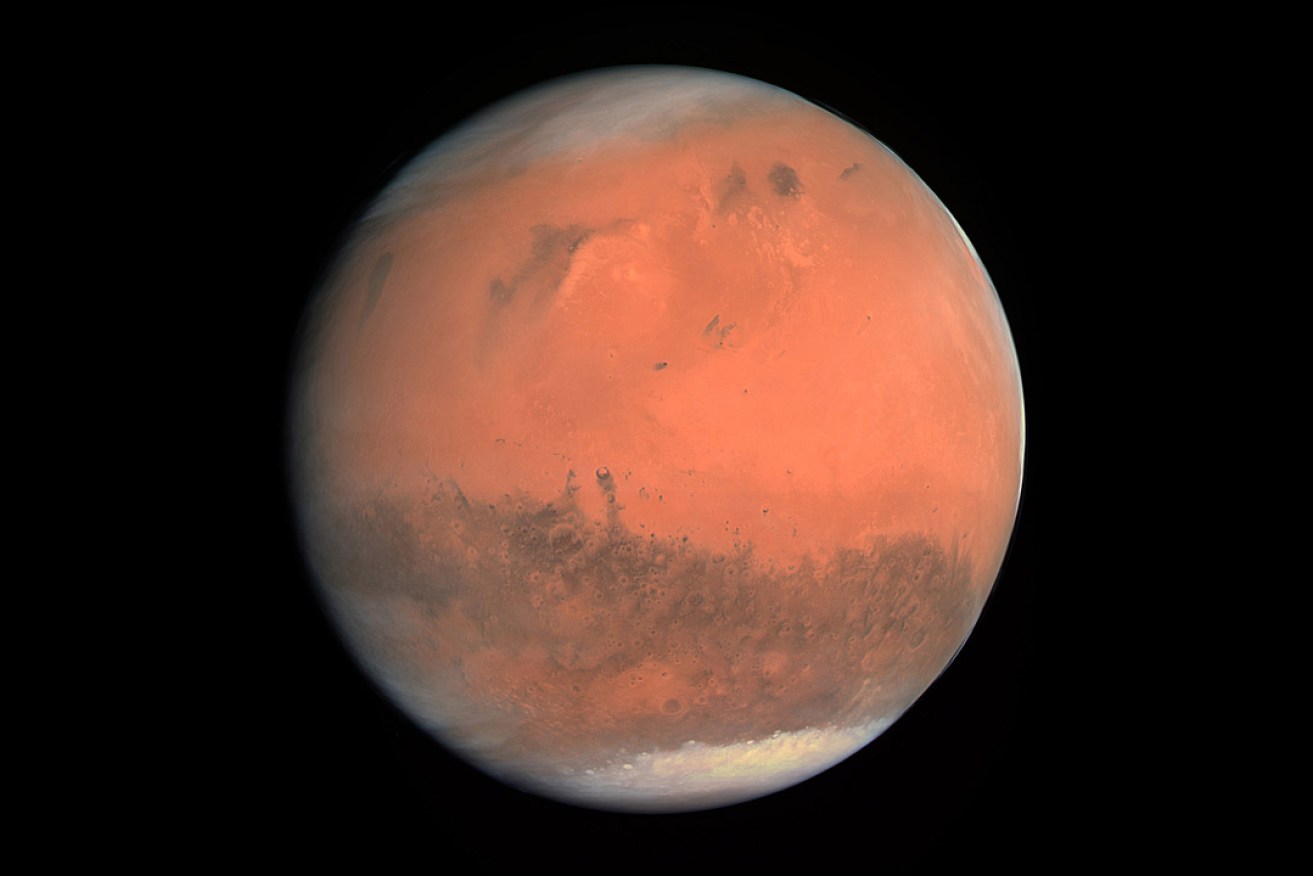SA scientist’s rocket fuelled by Martian metal, space junk
A South Australian scientist has developed a rocket that can be fuelled by magnesium harvested from space junk orbiting Earth or mined from the surface of Mars.

A true color image of Mars taken by the OSIRIS instrument on the ESA Rosetta spacecraft during its February 2007 flyby of the planet. Photo: European Space Agency/Wikipedia
Aerospace engineer Paddy Neumann will exhibit the Neumann Drive – a rocket capable of travelling long distances, fuelled by magnesium – at the International Astronautical Congress in Adelaide next month.
The rocket is stable enough to send a spacecraft from Earth’s atmosphere to Mars and back on a single block of the lightweight shiny-grey metal, and could also be propelled using other metals.
It has the potential to use metal harvested from discarded spacecraft and other rubbish from orbit, and use Mars, or one of its moons, as a refuelling station for long journeys into deep space.
The drive works in a manner similar to an arc welder, creating thrust by eroding material at the tip of a metal cathode (an electrode from which a conventional current leaves a polarized electrical device).
Once its material evaporates and is ionised it is “spat down range” causing a pulsating thrust and propelling the rocket forward, similar to the way a bullet leaving the barrel of a gun creates thrust in the opposite direction.
The 68th International Astronautical Congress will be held at the Adelaide Convention Centre September 25 to 28.
Up to 4000 delegates are expected to attend, including the heads of all the major space agencies and Space X founder and CEO Elon Musk.
Neumann Space is also joining an Airbus mission to the International Space Station (ISS) in 2019 to test its real-world capabilities and collect data.
The rocket will be tethered to the ISS for the year-long trial before a free-flight model is tested.

Neumann Space Chief Scientist and founder Paddy Neumann has developed a rocket that can be fuelled by space junk and materials from the surface of Mars. Image: supplied
Neumann said Mars had an abundance of magnesium, which raised the possibility of establishing a metal refinery on the planet to harvest more fuel.
“Harvesting the magnesium on Mars and feeding it back into the thrusters you could create a fuel stop for deep space travel,” Neumann said.
“You could also find magnesium in asteroids, as the mineral Olivine, so the potential is there.
“It would create more opportunities to study space but obviously there would then need to be a change to international space law for this to happen.
“It definitely is one of the best shots we have to continue to send satellites deeper.”
Researchers have found that magnesium is the optimal fuel source but materials such as tungsten, chromium and carbon have also been successfully trialled.
The Neumann Drive can produce thrust at more than 10,000 seconds for 1lb of thrust when magnesium is used as fuel.
This is significantly better than gridded iron thrusters, which max out at about 3500 seconds.
“Just like a combustion engine, our rocket would change size depending on what it’s connected to,” Neumann said.
“From a speedboat to an aircraft carrier it gets bigger and bigger and this could do the same thing in theory, or you can put multiple thrusters on a machine, it could change how we travel deeper into space.
“We haven’t tried using metals like iron, which could also work, but obviously magnesium has tested the best so far.”
According to the European Space Agency there are about 18,000 large objects in orbit and more than 90 per cent of them are space junk caused by more than 250 spacecraft explosions.
There are also millions of smaller pieces of debris floating in space, which are too small for radars to track.
Neumann said his research group was still working on developing a way to capture and reprocess space debris into a usable resource for the rocket when it is tested in space.
“A lot of the metals we are using already have aerospace applications and a lot of the structural parts of the (space) junk are made out of those metals,” he said.
The South Australian government is developing a space industry and has enlisted 11 local space start-ups, including Myriota, Fleet Space Technologies, Neumann Space and Inovor Technologies, to increase their footprint in the multi-billion-dollar global space industry.
Musk visited Adelaide earlier this month to announce the partnership between his company Tesla and French renewable energy company Neoen for the 100MW/129MWh battery at Neoen’s Hornsdale Wind Farm in the state’s Mid North.




